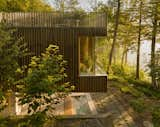How They Pulled It Off: A Cantilevered Green Roof
Welcome to How They Pulled It Off, where we take a close look at one particularly challenging aspect of a home design and get the nitty-gritty details about how it became a reality.
To pull off a sculptural green roof—and the 2,500-square-foot, off-grid-ready weekend getaway beneath it—it helps to have an international design firm at your disposal. Happily, this is the case for Louis Lemay, president of Montreal firm Lemay, and his partner, architect Stéfanie Roy. Lemay’s firm is known for large-scale commercial and civic projects with a "net-positive" approach centered on the well-being of users, environmental protection, and carbon reduction. The couple used their vacation home as an opportunity to collaborate with structural engineering firm Elema, builders Charpentes Montmorency and Constructions Pierre Ruel, and a multidisciplinary design team from Lemay to test this approach at a residential scale. (And yes, they put in a hot tub.)
Chalet Vale Perkins, named for a wooded valley on the western edge of Lake Memphremagog, is about an hour’s drive from Montreal. Louis built his first house there 25 years ago, designing it from prefabricated wood panels that could be carried onto the site and assembled without chopping down trees. The new house has a slightly heavier touch, including a concrete slab floor and retaining walls supporting a cross-laminated timber shell, but Lemay still prioritized minimal disturbance to the site. "I wanted to be as humble as possible with the mountain and the forest and the lake," says Louis. "As much as possible, I wanted it to look as if there were no construction."
The concrete, with a boost from radiant heating coils embedded in the floor, helps stabilize the home’s temperature. There is no air-conditioning, but, thanks to thermal mass and windows placed to capture the breeze, the inside air temperature hovers around 73 degrees Fahrenheit, even in the heat of the summer. Water comes from a nearby well. The house is connected to the power grid, but the old house (now used by the family’s grown children) is designed to accommodate both solar panels and battery storage. Once these are connected, the house will, on average, produce more energy than it consumes.
The green roof was a central part of the design from the beginning. "The house is a discovery," says Louis. "You don’t see it at first glance." The roof catches and filters site runoff before it enters the lake, and its thick insulated layer helps keep interior temperatures comfortable even when it’s covered in snow.
How they pulled it off: The green roof
• A green roof is heavy; depending on the design, it can add somewhere between forty and a hundred pounds per square foot to a roof load. First, there’s the roof structure, in this case a four-inch panel of cross-laminated timber. Then there’s a waterproofing membrane; then a layer of rigid insulation (in this case, Rockwool); then an additional water-permeable/dirt-proof membrane; then the soil mix and plantings. The bedroom suite is below, and all this floats above the hot tub. The 25-foot cantilever was achieved with wood beams; the engineers suggested steel, but it wouldn’t be a test house without a challenge.
• Lemay designed the slope of the roof to mirror that of the neighboring mountain. But too much slope, and the soil and plants would slide off. Louis found a French company, Soprema, who delivered a green roof product called Sopranature: rolls of soil embedded into mesh, creating a kind of plantable blanket that keeps the plants in place. "Actually, I was the first user of their system," says Louis, "and it works even better than I expected. It’s been almost five years now and it’s perfect."
• La Ligne Verte, Montreal green roof designers and installers who specialize in rooftop farms, did the installation. Lemay’s landscape architect selected plant species that would thrive in this location and climate. The roof has irrigation lines installed, but they were only needed for the first year. Now, the roof is lush and green in the summer, with planting beds for vegetables and herbs and a roof deck for catching the last rays of sun going down behind the mountain.
For Louis, the project has achieved net-positivity, professionally and personally. With no air-conditioning or furnace and appliances selected for their lack of noise, the soundtrack of the house is a natural one: birdsong, wind and waves. Does Lemay have any advice for others looking to incorporate a green roof into their own project? "It’s possible," he says. "You just need a good engineer."
Project Credits:
Architect: Louis Lemay, Lemay
Builder: Charpentes Montmorency and Constructions Pierre Ruel
Interior Design: Stéfanie Roy, Lemay
Structural Engineer: Elema
Published
Last Updated
Get the Dwell Newsletter
Be the first to see our latest home tours, design news, and more.











